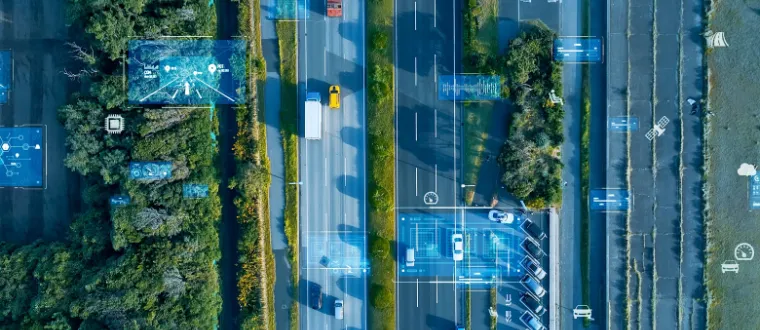

20 February 2025 - by: Eleonora Castagna
The Future of Road Transport Lies in Innovation: V2V, ADAS, AI, Radar and LIDAR Sensors
Road transport is entering a new era, where safety, efficiency, and sustainability are no longer just goals, but tangible realities enabled by advanced technologies.

Systems such as ADAS (Advanced Driver Assistance Systems), V2V (Vehicle to Vehicle), AI (Artificial Intelligence), radar, and LIDAR (Light Detection And Ranging) sensors are transforming the way vehicles interact with their surroundings and with one another—reducing accident risks, optimizing routes, and enhancing the driving experience.
This evolution doesn’t just affect individual vehicles—it is redefining the entire mobility ecosystem by creating a connected and intelligent infrastructure, capable of managing traffic more smoothly and reducing environmental impact. But what exactly are these technologies, how do they work, and what concrete benefits do they offer?
V2V: The Communication That Revolutionizes Driving
“Vehicle to Vehicle” refers to the ability of vehicles to exchange real-time data using wireless communication protocols. In practice, each vehicle is equipped with devices that allow it to “talk” to other vehicles on the road, sharing information such as speed, position, and direction of travel.
Why is this important?
- Road safety: V2V allows a vehicle to receive real-time alerts about obstacles or imminent dangers (e.g., sudden braking from the vehicle ahead).
- Traffic efficiency: By reducing reaction times, vehicles can better coordinate movements, lowering accident risks and improving traffic flow.
- Support for automated driving: V2V is the foundation for cooperative driving techniques such as platooning, where multiple vehicles travel in synchronized convoys to optimize fuel consumption and safe distances.
Advanced Driver Assistance Systems are a set of technologies designed to support the driver in various situations—from lane keeping and blind spot detection to emergency braking. One of the major advantages of these systems is the significant improvement in road safety, as they drastically reduce the risk of human error, which remains one of the leading causes of accidents. At the same time, they enhance driving comfort by relieving the driver from repetitive tasks and reducing fatigue during long journeys. Another key aspect is their versatility: many of these technologies are now available across a wide range of vehicles, from commercial trucks to private cars, promoting widespread adoption and driving progress across multiple sectors.
Common ADAS Examples
- Lane Keeping Assist: Helps keep the vehicle within the lane by intervening in case of unintended drifting.
- Adaptive Cruise Control: Automatically adjusts speed to maintain a safe distance from the vehicle in front.
- Blind Spot Detection: Alerts the driver to vehicles in the blind spot.
Artificial Intelligence is the technology capable of analyzing vast amounts of data and “learning” from it. In vehicles, AI processes data from sensors and communication systems, continuously improving the ability to perceive the surroundings and make real-time decisions.
Practical Applications
- Object and pedestrian recognition: Neural networks process images from cameras and sensors, enabling the vehicle to identify and classify obstacles.
- Autonomous driving: AI is the core engine enabling vehicles to “drive themselves” by dynamically interpreting road situations.
- Predictive maintenance: By analyzing vehicle usage data, AI can predict failures and indicate maintenance needs before serious issues occur.
Radar and LIDAR sensors are two essential technologies for environmental perception in advanced vehicles. Radar works by emitting radio waves that bounce off objects or people and return to the vehicle, allowing precise calculation of distance and relative speed. This system is particularly effective in low visibility conditions, such as fog or heavy rain.
LIDAR (Light Detection and Ranging), on the other hand, uses laser pulses to create a three-dimensional map of the surrounding environment. Each laser beam is reflected off objects and returned to the sensor, enabling the creation of a highly detailed reconstruction of what surrounds the vehicle. Thanks to its high precision, LIDAR is a key technology for autonomous driving systems, as it allows for accurate identification of vehicles, pedestrians, and road infrastructure—greatly enhancing detection and reaction capabilities.
Why Are These Technologies Crucial?
- Precision: Radar and LIDAR provide accurate measurements even in poor visibility conditions (rain, fog, darkness).
- Redundancy: Integrated with cameras and other sensors, they ensure a complete “vision” of the environment, minimizing the risk of detection errors.
- Advanced autonomous driving: The combination of these sensors enables the development of increasingly high-performance ADAS and autonomous driving systems.
The large-scale implementation of these technologies also comes with challenges. A stable network coverage (often relying on 5G) is required for V2V to function correctly; professional drivers need to be properly trained on the role of ADAS and AI systems; clearer regulations must be developed to define responsibilities and operating limits for semi-autonomous or fully autonomous vehicles. Additionally, cybersecurity becomes a central concern, as continuous communication between vehicles and the cloud must be protected from potential tampering.
However, the outlook is promising: as technology costs decrease and regulations become standardized, we will increasingly see fleets of heavy-duty and commercial vehicles equipped with advanced communication systems, next-generation ADAS, and intelligent AI systems capable of learning and adapting to real-world road conditions.
Share




























